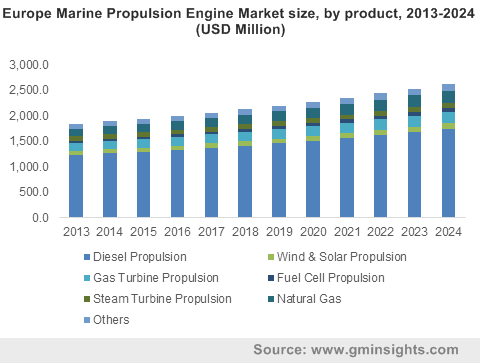APAC Marine Propulsion Engine Market to witness significant gains over 2016-2024, China and South Korea to be the major revenue pockets
Publisher : Fractovia | Published Date : 2017-05-05Request Sample
Marine Propulsion Engine Industry is gaining a substantial traction on the grounds of powering the world’s largest ships that transport cargo across the globe. Over the years, there has been a tremendous increase in the international trade through marine transportation due to its cost-effectiveness. Consequently, there is a high demand for fuel efficient ships, which will propel marine propulsion engine market. Basically, marine propulsion refers to the mechanism that produces the required thrust for driving the marine objects. The propulsion engines used in these marine vessels are a fascinating piece of machinery which are undergoing rapid development and product upgradation for energy efficiency and high performance. In this regard, some of the world’s finest marine propulsion engine industry players such as Rolls-Royce and Wärtsilä are emphasizing on diversifying their product portfolios to explore sustainable transportation solutions.
There have been increasing efforts to modernize the marine propulsion engine market to develop engines that are likely to reduce fossil fuel consumptions and make use of renewable energy instead. Thus, rising emphasis on implementing solar and wind energy as an alternative fuel methods for engine propulsion will further boost the industry growth. According to Global Market Insights, Inc., “Marine propulsion engine market size is estimated to grow at an annual rate of 4.3% over the period of 2016-2024.”
Europe Marine Propulsion Engine Market size, by product, 2013-2024 (USD Million)

Concerns over the environmental issues and energy conservation has gained immense attention over the years. A considerable amount of carbon emissions from conventional systems has prompted the regulatory bodies to enforce norms that mitigate the carbon footprints due to engine exhaust gases. For instance, the Marine Pollution Convention (MARPOL) has introduced such regulations to prevent the environment from chemical spills, air pollution, contamination by oil and sewage. Also, in the event that the companies operating in marine propulsion engine industry attempt to violate these norms, they may be subject to heavy penalties from the government.
Rising proximity of wind and solar energy as auxiliary power sources will lead this segment to register a CAGR of 5.9% over the period of 2016-2024, having had a contribution of 3.5% of overall marine propulsion engines market stake in 2015. Apart from this, diesel, steam turbine, gas turbine, fuel cell, and natural gas are the noticeable product segments of marine propulsion engine market. The gas turbines product segment is witnessing lucrative gains, owing to its the high-speed sprint operation mode. Such turbines are in great demand in the military & naval sector, thus, boosting the growth prospects of marine propulsion engine industry.
With the depletion of conventional and shale gas reserves, liquefied natural gas is emerging as an efficient source of fuel in marine propulsion engine industry. Growing adoption of liquefied natural gas as a propulsion medium in the United States has significantly boosted the revenue share of marine propulsion engine industry in the region. Furthermore, steam turbines are becoming a sustainable option for the alternative fuel source and are anticipated to offer tremendous business scope due to their utilization in coal carriers.
The deployment of new-age technologies such as fuel injection, firing pressure, and turbo-charging in diesel propulsion engines will positively affect the market valuation of diesel marine propulsion engine industry. Diesel engines are majorly used due to their high efficiency and high power generation capacity. In addition, a significant rise in the adoption of electric transmission systems will stimulate the fuel cells product deployment in the coming years. Fuel cells marine propulsion engine market has gained considerable traction, owing to its high performance in auxiliary impulsion and low-power machinery.
Asia Pacific marine propulsion engine industry accounted for more than 50% of the overall share in 2015, with a revenue generation of more than USD 4.5 billion. China and South Korea are the prominent revenue contributors. These countries have been investing heavily in regional marine propulsion engine market, thereby augmenting APAC market share. Moreover, favorable government initiatives for the development of solar & wind energy powered products in the region will also drive the market demand.
Key marine propulsion engine industry participants are likely to focus on research and development activities to come up with environmentally sustainable and economical technologies. Notable market players include Mitsubishi, MAN Diesel & Turbo, Wärtsilä, Volvo Penta, Hydraulic Marine Systems, Caterpillar, Exxon Mobil Corp, Yamaha, Sinopec, Hydrosta BV, and Cummins.